Metro Trains Melbourne Agile course development on electrical safe operations in Rail Tunnels & Level Crossing Removal
Working closely with Metro Trains Melbourne (MTM) to develop courseware to educate their workers and contractors in complex and hazardous construction environments.
Background
Victorians are experiencing the building of the largest ever rail infrastructure pipeline, with more than $30 billion invested in metropolitan and regional rail projects.
These projects include the Metro Tunnel which will create a new end-to-end rail line from Sunbury in Melbourne’s west to Cranbourne/Pakenham in the south-east, the removal of 75 level crossings across Melbourne, the Geelong Fast Rail which will be enabled through a major investment to the Werribee corridor. Other projects include Melbourne Airport Rail, the Cranbourne Line Upgrade and Regional Rail Revival.
Metro Trains Melbourne staff and Alliance Partners require training to ensure they are competent and skilled to work safety in the rail corridor. Thomson Bridge’s partnership with Metro Trains Melbourne (MTM) delivers electrical and hazard management training programs that are developed specifically at the direction of MTM and the Level Crossing Removal Project.
This is an environment where there is a lot of infrastructure work going on. MTM has a big and highly mobile workforce and recognise that training is important for safety and skill development. So MTM needed a training partner that was electrically literate that could work in an agile and collaborative mode to develop short courses and a choice of training delivery modes as needs arise.
Our role
Thomson Bridge develops customised electrical safe access and operator training for the rail infrastructure and project teams in what is an extremely complex and hazardous construction environment. It’s material that is fit for purpose for MTM’s own staff and meets the requirements of their training and authorisation processes. Additionally, it includes development of training and delivery of training courses for the Alliance Partners and contractors to ensure that they are competent and skilled to work safely in the rail corridor.
Some of these courses include HV Operator for Lines, Signals and Substations, Recipient, Applicant, Permit to Work Near, Underground Safety Spotter, and the Rail Corridor Construction induction for Planning and Project Managers.
We found that MTM were spending a lot of their own staff time on upskilling contractors on activities such as how to apply for a permit. So, we worked with them on methods to reduce their own staff time used to educate people on MTM business practices, especially with contractors on how to do business with MTM safely and efficiently.
Working closely as partners, we developed the optimum delivery mode to meet the key messages and learnings that MTM want to convey to their community. These modes include face to face; virtual and self-paced. Some programs requires for practicals, some are short and only require one to two hours, which others require one to two days.
Project Details
Client: Metro Trains Melbourne
Location: Victoria
Industry: Rail and HV Operations
Our Role: Working closely with MTM to develop courseware to educate workers and contractors on electrical safe access and operator training in complex and hazardous construction environments.
Outcome: Ongoing partnership with an electrically literate training organisation for course development for MTM workers on electrical safe operations in rail tunnels and Level Crossing Removal construction.
Related Case Studies:
Yarra Trams - Electrical Safety Rules Education program for staff & contractors
Level Crossing Removal Project - Building courseware to address rail skills shortages in critical infrastructure works
